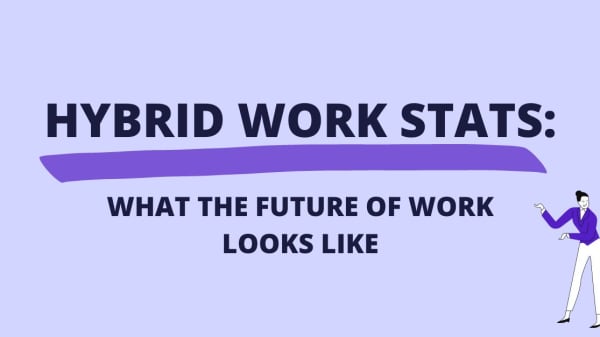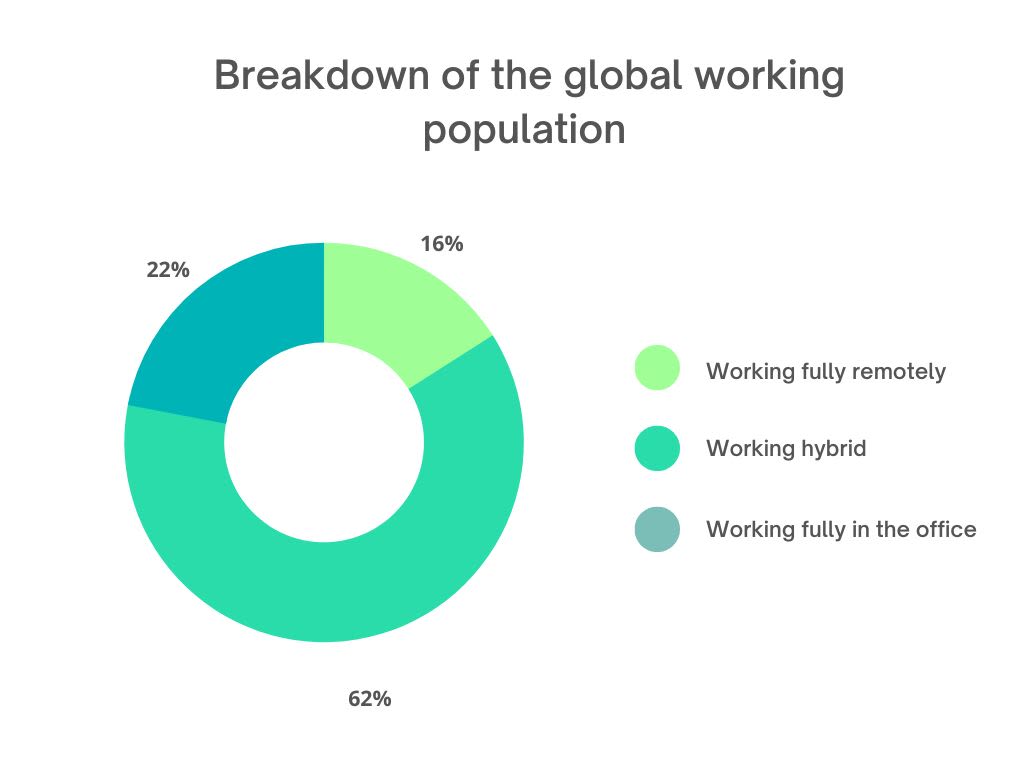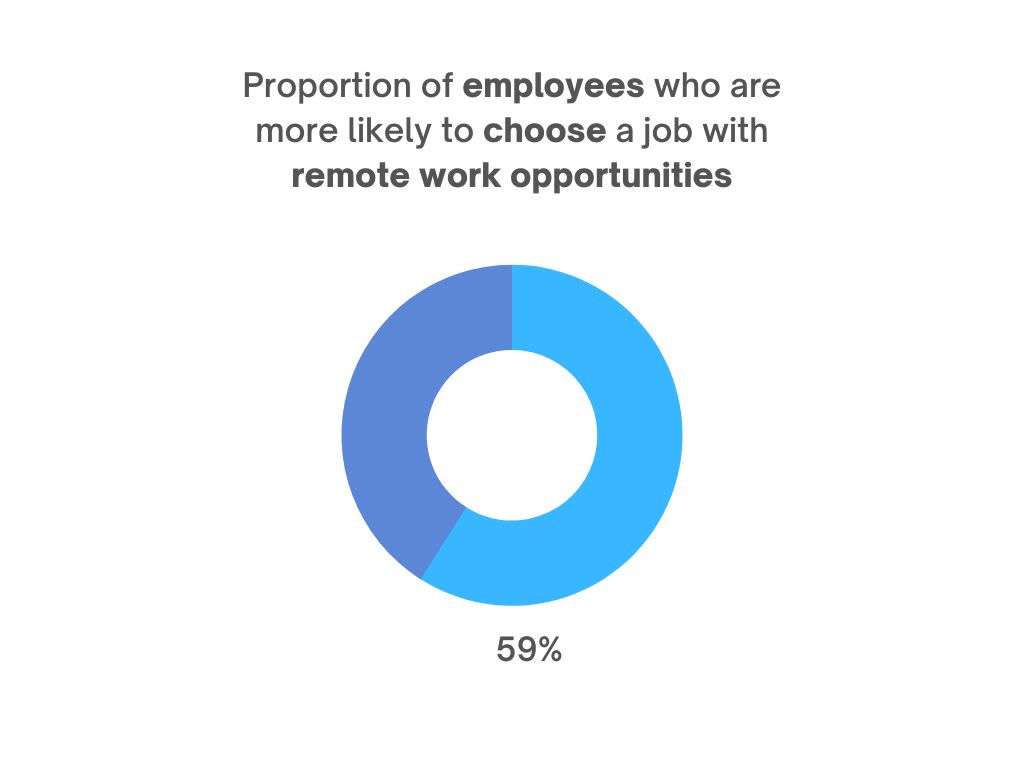
Hybrid Work Statistics: What The Future Of Work Looks Like
October 20, 2022

63% of high revenue growth companies use a 'productivity everywhere' hybrid work model, and following the COVID-19 pandemic, only 8% of employees who embarked on remote working through lockdown necessity want to return to the office full time.
According to a 2021 report by Owl Labs, the breakdown of the global working population was as follows:
Just these statistics demonstrate that hybrid working might be the future of what work looks like as we move on through a post-pandemic world - but what is the reality of hybrid work models?
How does hybrid working impact customer satisfaction, employee wellbeing, and most importantly for businesses, how does adopting, developing or maintaining a hybrid work plan impact costs and profit?
What is hybrid working?
Hybrid work models combine work that takes place both in-office as well as at home or remotely. On the surface, hybrid working allows employees the choice to work where it suits them best - in the office for meetings and team building, or at home where they can focus more.
There are several types of hybrid work models that businesses can implement:
- Flexible: staff are free to decide which days they work from home, in the office, or elsewhere depending on what tasks need to be completed.
- Fixed: employees have set days to be in the office, either as a team or as a whole company, for team building, training and meetings.
- Office-First: preference is given to days spent in the office, with less days remote
- Remote-First: more days worked remotely, with less days needed to be in the office.
Before the pandemic, many office-based workers that could potentially work from home (if they had the right networking capabilities) were at the office; but once lockdowns were implemented many larger businesses operated completely remotely.
As 'return to the office' became a government priority in the UK and around the world, employees have become more aware of what they can achieve at home, with the benefit of accessing the office when they want to - which is why 44% of workers favor a hybrid working model according to the Remote Work and Compensation Pulse Survey from May 2021.
The rise of hybrid work
Remote work really became the norm during COVID-19, ensuring that businesses could continue providing their services for customers even when close personal contact was disallowed.
Employees could not physically be at the office, and for businesses that had the capability, the opportunity to ensure continuity was important enough for remote working to be the norm. In fact, 47% of employees in the UK worked from home during the first lockdown.
It is important to note that even as the lockdown rules eased globally, many employees were not prepared to return to the office in any capacity - mostly to protect their own health. 32% of employees reported that they found avoiding Covid was a major benefit of remote working during the pandemic.
Who is doing hybrid work?
It is worth noting that not every industry or workplace is suited to hybrid work plans - those that require in-person tasks to be completed, like assembly and manufacture, for example, or roles in hospitality, working in shops, or as a cleaner.
This makes a rather large disconnect in the type of person that is capable of working remotely, just because of the type of work that they are doing.
38% of people that work both in the office and at home earn more than £40,000 a year, and only 8% of those earning less than £15,000 a year work in a hybrid way. This accounts for the high number of executives that are able to take advantage of hybrid working, as well as the types of industry that it works for, such as most office-based businesses.
Age is important too. 42% of Generation Z want to work remotely 1-2 days a week, while 37.8% of Millennials want to work remotely 3-4 days a week.
Companies that rely on hybrid work patterns
There are many well-known companies that have already made hybrid working a part of the normal schedule for employees, including:
- Apple
- Microsoft
- Amazon
- Slack
- Spotify
- 3M
- InVision
74% of US companies use a hybrid working model or are planning on implementing one, including the well-known names above, and 55% of employees want to work remotely at least three days a week.
The companies that are not embracing a hybrid model and are instead focusing on all remote or all in office are much more likely to have problems with profit and growth - 69% of businesses who reject hybrid have either negative growth or no growth at all.
The benefits of hybrid work
Better work/life balance
78% of employees have said that a hybrid work plan leads to a better work/life balance. Working from home improved the well-being for 47% of workers, while 52% mentioned that they could do their work quicker at home than in the office.
Flexibility is important, and this is more apparent with 64.2% of Millennials saying that they want the office space for collaboration with other team members.
Choosing where to work and how that will look on a personal level is important, and 80% of employees are able to complete all their work-related tasks remotely - which means they can focus on work at home, and use the office for training, meetings, collaboration and team building.
Improved productivity
36% of employees have said that they are more productive at home, due to a lack of distractions from other colleagues. 58% of employees surveyed by McKinsey reported that hybrid working improved their productivity.
Executives might not be fully on board with the idea that working remotely is best for productivity, with 65% believing that the office is necessary for best productivity, which makes hybrid working a good middle ground for what the C-Suite and the staff want.
Hybrid workplaces have seen an average 12% reduction in employee turnover, and 85% of staff that see themselves as capable of 'productivity anywhere' are more likely to stay with a business long term - so productivity remains constant without extra costs of staff recruitment and training.
More attractive for staff
59% of employees are more likely to choose a job with remote work opportunities, and online job searches for remote work grew by 460% between June 2019 and June 2021, a figure that has remained steady since.
Staff want the opportunity for flexibility in where they work, and 54% of employees would leave a job for one that offered more opportunities for remote work.
Cost savings
Companies can save anywhere from $5,000 to $11,000 per employee when they work part of their time in a remote location.
Even considering the expenses of setting up a hybrid work plan, from remodeling existing office space to ensuring that employees have the right equipment to work from home, companies can save a lot of money from hybrid working - and so can employees.
46% of people working from home say that their spending has decreased, and 75% of hybrid workerssay that overall cost savings are the biggest benefit of this way of working. More than a third report that they save $5,000 a year working remotely, from the cost of food and drink to commuting.
In fact, losing the commute is the best benefit to working from home for 84% of people.
The challenges of hybrid work
Disconnect between in-office and remote employees
Those out of the office will have less face-to-face time with their colleagues and with management, and this can cause a disconnect. In-person relationship building is not impossible remotely, but it is much harder to feel part of the community if you do not see any of your coworkers throughout your working day.
32% of those that work remotely have said that they feel disconnected from the company culture, and 24% said that working remotely had a negative impact on their relationship with coworkers.
The other thing to consider in terms of disconnect is the way new starters might feel - a lack of direct in-person supervision on 'remote' days might lead to issues with productivity and capability as well as loneliness.
Lack of growth opportunities
Arranging and accessing growth and development opportunities from home is not easy, and getting face-to-face time with managers and mentors is a scheduling juggle for hybrid workers.
It is not a stretch to assume that employees will need to be in the office to access all the opportunities available to them; those who are remote first might not get access to the promotion opportunities that are available, and there is still some assumption even in the most modern workplaces that you cannot hire a remote manager - and this is a mindset that comes from the executive suite themselves with 65% of executives believing that the office is needed.
In addition to this, chances for personal developmentmight be missed, with less chance meetings in a corridor leading to special project work, for example.
Risk of burnout
Employees working remotely find that they often work longer hours than they would in the office, whether or not they are being more productive. This 'always on' mentality might be in part as a way to prove that they are not slacking when they are not in the office, or it might be because it is not easy to switch off from work when you can just get that last thing done or that last email sent.
30% of remote workers report that they have increased their hours working from home, and this can lead to burnout. Employees may feel that they are neither here nor there when they are balancing their workload between home and the office.
Pay problems
92% of employers do not have a plan in place to work out the pay structure for hybrid workers. While 97% of those surveyed will not reduce pay for those that work partially remote, 83% of employees stated that they would leave their job if they were paid less because they were working remotely.
Compensation is an important consideration for employees - 94% think that their pay should reflect their abilities, not where they work - but some employers have said that they would not pay the same for a remote worker that was not in the same geographical location as the office.
Boost your hiring power.
Start using Neuroworx today.
Talk is cheap. We offer a 14-day free trial so you can see our platform for yourselves.
Try for free





